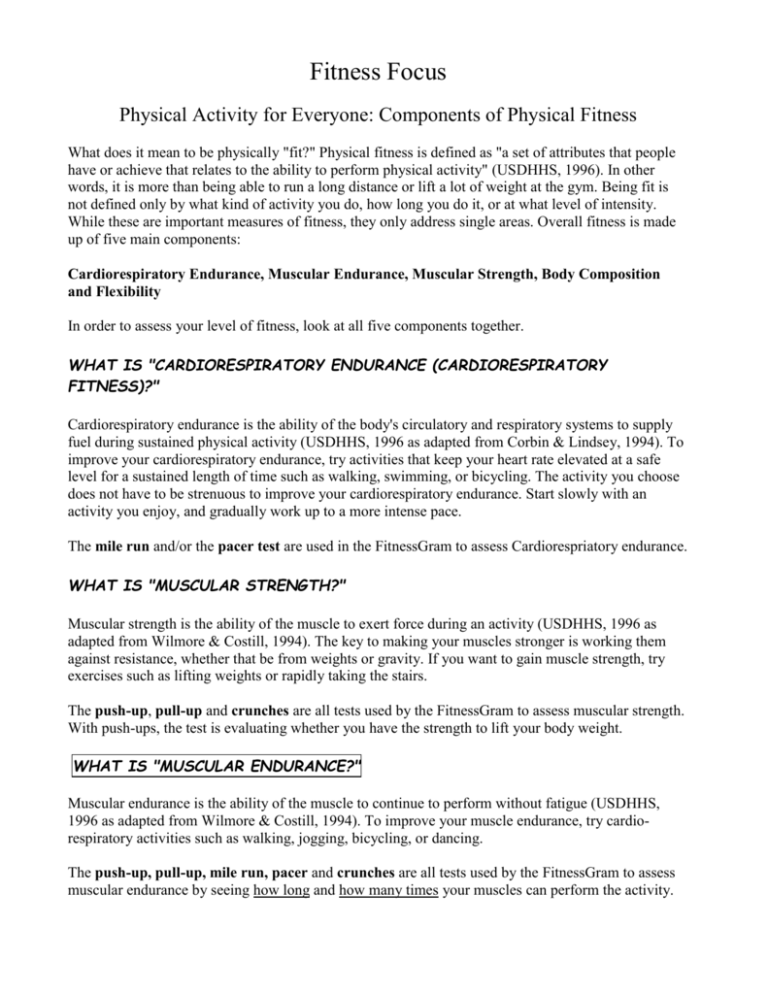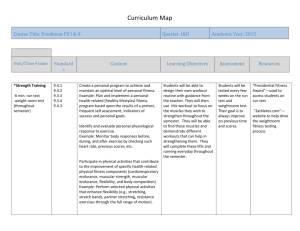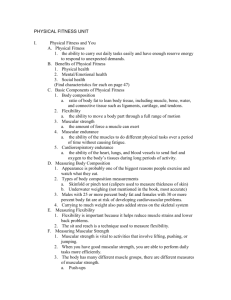Physical Activity for Everyone: Components of Physical Fitness
advertisement

Fitness Focus Physical Activity for Everyone: Components of Physical Fitness What does it mean to be physically "fit?" Physical fitness is defined as "a set of attributes that people have or achieve that relates to the ability to perform physical activity" (USDHHS, 1996). In other words, it is more than being able to run a long distance or lift a lot of weight at the gym. Being fit is not defined only by what kind of activity you do, how long you do it, or at what level of intensity. While these are important measures of fitness, they only address single areas. Overall fitness is made up of five main components: Cardiorespiratory Endurance, Muscular Endurance, Muscular Strength, Body Composition and Flexibility In order to assess your level of fitness, look at all five components together. WHAT IS "CARDIORESPIRATORY ENDURANCE (CARDIORESPIRATORY FITNESS)?" Cardiorespiratory endurance is the ability of the body's circulatory and respiratory systems to supply fuel during sustained physical activity (USDHHS, 1996 as adapted from Corbin & Lindsey, 1994). To improve your cardiorespiratory endurance, try activities that keep your heart rate elevated at a safe level for a sustained length of time such as walking, swimming, or bicycling. The activity you choose does not have to be strenuous to improve your cardiorespiratory endurance. Start slowly with an activity you enjoy, and gradually work up to a more intense pace. The mile run and/or the pacer test are used in the FitnessGram to assess Cardiorespriatory endurance. WHAT IS "MUSCULAR STRENGTH?" Muscular strength is the ability of the muscle to exert force during an activity (USDHHS, 1996 as adapted from Wilmore & Costill, 1994). The key to making your muscles stronger is working them against resistance, whether that be from weights or gravity. If you want to gain muscle strength, try exercises such as lifting weights or rapidly taking the stairs. The push-up, pull-up and crunches are all tests used by the FitnessGram to assess muscular strength. With push-ups, the test is evaluating whether you have the strength to lift your body weight. WHAT IS "MUSCULAR ENDURANCE?" Muscular endurance is the ability of the muscle to continue to perform without fatigue (USDHHS, 1996 as adapted from Wilmore & Costill, 1994). To improve your muscle endurance, try cardiorespiratory activities such as walking, jogging, bicycling, or dancing. The push-up, pull-up, mile run, pacer and crunches are all tests used by the FitnessGram to assess muscular endurance by seeing how long and how many times your muscles can perform the activity. WHAT IS "BODY COMPOSITION?" Body composition refers to the relative amount of muscle, fat, bone, and other vital parts of the body (USDHHS, 1996 as adapted from Corbin and Lindsey, 1994). A person's total body weight (what you see on the bathroom scale) may not change over time. But the bathroom scale does not assess how much of that body weight is fat and how much is lean mass (muscle, bone, tendons, and ligaments). Body composition is important to consider for health and managing your weight! The Body Mass Index (BMI) which looks at your height and weight is used by the FitnessGram to assess body composition. WHAT IS "FLEXIBILITY?" Flexibility is the range of motion around a joint (USDHHS, 1996 as adapted from Wilmore & Costill, 1994). Good flexibility in the joints can help prevent injuries through all stages of life. If you want to improve your flexibility, try activities that lengthen the muscles such as swimming or a basic stretching program. The Sit and Reach as well as the Right and Left Shoulder Stretch and the Trunck Lift are used by the FitnessGram to assess your body’s flexibility.








